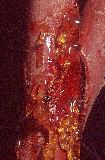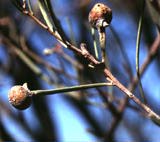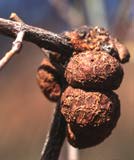|
[Front Page] [Features] [Departments] [SGAP Home Page] [Subscribe]

Mulga
Acacia aneura F.Muell. ex
Bent.
Horst Weber
|
akakia
|
(Greek) = name for the Egyptian thorn
(A.
arabica), derived from akis, a sharp
point or object
|
|
a
neuron
|
(Greek) = without, not, un-
(Greek) = sinew, nerve
|
So this plant is
the
sharp-point-plant without
nerves
(a reference to the
phyllodes)
|
One of the few acacias with a long life
Mulga is a truly amazing plant. Among the acacias, many of which are relatively short-lived, it is
a species with a long life. It is also a good fodder tree, its wood is valuable for a variety of purposes and the tree grows in many parts of Australia.
In favourable conditions young plants will grow at a rate of 1 metre every 10 years until the tree reaches its maximum height of 10 metres. Reduced rainfall or drought conditions will slow down this process or bring it to a temporary halt, which means that a mature tree will usually be more than 100 years old. The counting of growth rings on felled trees has revealed the stunning number of 150-240 rings in stems of only 25 cm diameter. In their lifetime these trees would have experienced a number of drought years when no growth rings develop and therefore grew older in years than the exact number of growth
rings indicate.

|
Acacia
aneura at Arkaroola, northern Flinders Ranges.
Select the thumbnail image or plant name for a higher resolution image
(38k).
Photo: H.Weber.
|
The resourceful way in which the plant utilises every drop of moisture assists its survival to such a proud age. A sophisticated arrangement of its phyllodes and branches ensures that rainwater is channelled to the stem and onto the ground right to its deep taproot (seedlings of only 10cm height have been found to have taproots reaching 3m deep into the ground).

|
Leaflets and branches of Mulga Select the thumbnail image or highlighted word for a higher
resolution image
(16k).
Photo: H.Weber.
|
To Aboriginal people in Australia Acacia aneura used to be one of the most important
plant food sources.The seeds of the plant were separated from their pods by an elaborate process involving rubbing, threshing, parching and winnowing and the completely pod-free seed was then moistened with water and ground to an edible paste. A sweet exudation, produced by the plant after attack by a sap-sucking insect, was either sucked straight from the plant or dissolved in water to make a refreshing sweet drink. This was also eaten by early settlers who referred to it as "bush lollies".
The so-called mulga-apples, swellings of the plant following insect activity, however, are inedible.
 |
 |
Left: Ripening seed pods.
Right: "Bush lollies".
Select a thumbnail image or highlighted phrase for a higher resolution image (29k and 36k).
Photos: Horst Weber; Brian Walters
|
You may have observed a white, powdery substance on Mulga leaflets and small branches. This was utilised as a source of resin for joining tool-parts and for repairing cracks or holes in wooden bowls. The hard wood of mulga which turns dark red-brown when polished, could be turned into excellent tools such as spear-throwers, spearheads, barbs, boomerangs and digging sticks.
One such tool, a small, flat shield called "mulga" by one Aboriginal tribe gave the plant its common
name.
|

|
Branch with leaflets and swellings. Small amounts of the white, powdery substance can be seen on branch and leaflets. Select the thumbnail image or highlighted word for a higher resolution image
(29k).
Photo:
H.Weber.
|
Aborigines in the Northern Territory utilised the healing qualities of mulga in various different ways. People suffering from colds and flu-like illnesses utilised the healing qualities of young leaflets and
twigs which were picked and immediately boiled in water. The brown, aromatic liquid was then used as a wash which could be applied as often as desired during the day. Headaches associated with colds could be eased by heating young leaves and twigs on hot ashes or hot stones until soft and scorching, when they
were placed over the aching area.
The plant could also be utilised for post-natal therapy believed to strenghten mother and baby. Leaves of the plant and small pieces of termite mound were layered over hot coals and the mother with her newborn child would lie down on top of a layer of branches and leaflets to sleep while the smoke and vapour passed over their bodies. In some areas, only leaves and twigs were used and no pieces of termite mound.
|

|
Swellings of the branch after insect activity. Select the thumbnail image or highlighted word for a higher resolution image (27k).
Photo: H.Weber.
|
To the stock of white pastoralists the tree provides shade, shelter and forage. Feeding, however, is not completely without problems. The high protein content of the foliage is not easily digested and
this is probably due to a chemical reaction, occurring during digestion, between the leaves' tannin and the protein. After long periods of feeding on mulga, indigestible fibre balls have been found in sheep's rumen.
Mulga wood was used extensively by the early settlers. It was particularly valuable for fencing, the production of charcoal and for building bullock yokes and the multitude of uses lead to massive clearings of mulga in some areas, further compounded by the devastating impact of feral goats.
The disappearance of mulga usually goes hand in hand with a spread of grasses, thereby leading to increased termite activity and this may result in greater erosion during dry times. Furthermore, disappearing Mulga decreases nitrogen levels in the ground, depriving other valuable desert plants of food. This is due to a symbiotic relationship between acacias and a nitrogen binding bacteria called Rhizobium. Naturally, mulga's normally long life plays a strong part in a staple provision of nitrogen. Acknowledging these qualities, efforts are made today to strengthen and increase the mulga population in may parts of Australia, including the Flinders Ranges in South Australia.
Enjoying those efforts are regular "guests", for instance butterflies like the Blue-spotted lineblue (Nacaduba biocellata biocellata) and the Icilius blue (Jalmenus icilius) as well as more
permanent "tenants" like mistletoes. Its long life makes Acacia aneura an ideal host-plant for a number of mistletoes the fruit of which attracts many birds which in turn assist in spreading the mistletoe seeds.

|
Flower. Select the thumbnail image or
highlighted word for a higher resolution image
(16k).
Photo: H.Weber.
|
Description:
|
Plant
|
Shrub or tree, up to approximately 10 m high;
branches ascending or horizontal, branching about 1
m
above ground; trunk 20-30 cm diameter
|
|
Leaves
|
general note
|
Most acacias have no leaves in the proper
botanical sense but so-called leaflets or phyllodes
|
|
Colour
|
Greyish-green
|
|
Size
|
variable; 3-25 cm long, 1-10 mm wide
|
|
Shape
|
Variable; compressed cylindrical, narrow linear
or narrow elliptic; straight or curved
|
|
Surface
|
Minutely downy; very fine linear marks,
sometimes
visible only under a lens; young
phyllodes may be sticky
|
|
Margins
|
Yellowish;
Tip: blunt or
showing a recurved or slanted point
|
|
Flowers
|
Time
|
At any time of the year, following suitable
rains
|
|
Growing pattern
|
Dense spikes on stalks, usually 1, sometimes
2
growing out of leaf axils; stalks 3-10 mm long,
covered with short white hair
|
|
Colour
|
Bright yellow
|
|
Size
|
15-30 mm long
|
|
Shape
|
Dense spike
|
|
Fruit
|
Colour
|
Brown, when ripe
|
|
Size
|
20-35 mm long, 5-14 mm wide
|
|
Shape
|
Flat, broad pod, oblong or narrowed towards
base;
divided
|
|
Surface
|
Somewhat sticky, narrowly winged
|
Should you travel to South-Australia, yor journey may lead you from Port Augusta to Quorn and Hawker. Not far from Hawker are the Kanyaka ruins. It has been suggested (Tame, T., 1992) that the mulga plant used for the very first botanical description was collected at Kanyaka by the botanist Friedrich von Mueller in 1851.
In older plant books you will come across the name "Broad-leaf mulga, A. aneura var. latifolia. Since 1992, this species is now classified as A. ayersiana var. latifolia. The reasons for this change are given as follows:
" Typical mulga is recognised by narrow phyllodes, most of which are less than 3 mm wide. All individuals in this species are linked by the possession of glandular, epidermal hairs, and flat, chartaceous pods with (usually) inconspicuous wings". (Tame, T., 1992).
References
- Beadle, N.C.W., 1981, The
Vegetation of Australia
- Boland, D.J., 1984, Forest
trees of Australia
- Brand, J.C./Cherikoff, V., 1985, "The
nutritional
composition of Australian Aboriginal food
plants of the desert
regions", in: Wickens, G.E. et
al(Ed), Plants for Arid
Lands
- Cribb, A.B./Cribb, J.W., 1975,
Wild Food in
Australia
- Cunningham, G.M. et al, 1981,
Plants of Western New South
Wales
- Friedel,
M.H., et al, 1993, "What
induces Central Australian Arid Zone
Trees and Shrubs to
Flower and Fruit?" in Aust. J. Bot.,
41
- Greenwood, G., et
al, (Dept. of
Environment & Planning,), no year, "Flinders
Ranges
&endash; Management Review; Investigation
Report"
- Hall, N, et al,
1972, The use of trees and shrubs in
the dry country
of Australia
- Hodgkinson, K. C./Oxley, R. E., 1990,
"Influence of Fire and Edaphic Factors on Germination of
the
Arid Zone Shrubs Acacia aneura, Cassia nemophila and
Dodonaea
viscosa " in: Aust.J.Botany, 38
- Jessop, J.P.(Ed.), 1993 (Edition IV),
A list of the vascular plants
of South
Australia
- Jessop, J.P., 1986, Flora of South Australia
- Maconochie, J.R., 1985, "Plants of
the
Australian arid zone &endash; an undeveloped
potential", in:
Wickens, G.E., Plants for arid
lands
- Mahood, I.T.,
1995, "Feral Goat", in:
Strahan, R.(Ed.), 1995, The
Complete book of Australian Mammals
- Oxley, R.E.,1990, "Influence of
Fire
and Edaphic Factors on Germination of the Arid Zone
Shrubs Acacia aneura, Cassia nemophila and Dodonaea
viscosa" in: Aust. J.Botany, 38
- Randel, B.R., 1992, Mulga,
a revision of the major
species
- Smith, N.N., 1991, "Ethnobotanical
Field Notes from the Northern Territory" in:
J.Adel.Bot.Gard.
14(1)
- Specht, R.L..,
1972, The Vegetation of South
Australia
- Stearn,
W.T., 1992, Botanical Latin - Fourth
Edition,
- Tame, T., 1992, Acacias of Southeast Australia
- Whibley, D.J.E, 1980, Acacias of South Australia
Horst
Weber is a teacher and IT-manager
at
the German Cultural Institute, or "Goethe-Institut",
Dublin. In 1987, on his first
visit to
Australia, he fell in love with the private nature
sanctuary,
Arkaroola-Mt-Painter in South-Australia where he became interested
in
botany.
He is a member of "The Friends
of the Australian Arid Lands
Botanic Garden, Port Augusta". During
1999 he will develop a
Website for the Botanic Garden.
Horst gratefully acknowledges sponsorship by Arkaroola Pty.
Ltd, Australian
Geographic
Society, Flair Travel
(Dublin) and
Singapore
Airlines

[Front Page] [Features] [Departments] [SGAP Home Page] [Subscribe]
Australian Plants online - December 1999
Association of Societies for Growing Australian Plants
|